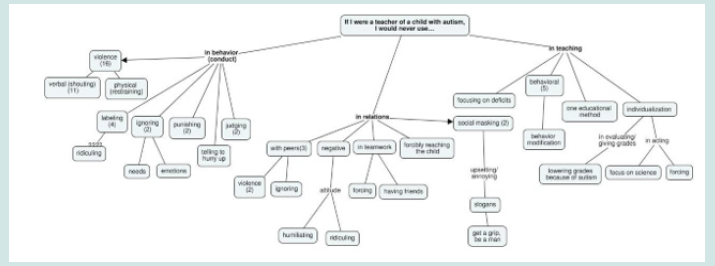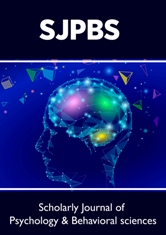
Lupine Publishers Group
Lupine Publishers
Menu
ISSN: 2641-1768
Research ArticleOpen Access
People with Autism Spectrum Disorders and their Perception of Education Volume 7 - Issue 3
Jacek Jaroslaw Bleszynski*
- Cardinal Stefan Wyszynski University in Warsaw, Poland
Received:July 20, 2023; Published:August 1, 2023
Corresponding author: Jacek Jaroslaw Bleszynski, Cardinal Stefan Wyszynski university in Warsaw, Poland
DOI: 10.32474/SJPBS.2023.07.000264
Abstract
Having collected and analysed the data regarding the perspectives of people with autism spectrum disorders (ASDs) about autism, I continued my research focusing on their perception of the education system, as well as conducting netnographic interviews.
Keywords: SR-HRM; Competitive Advantage; Innovation; Team Member Exchange; Servant Leadership
Introduction
In this study, a rather rare practice was applied, that is, employing netnographic research to obtain information directly from people with ASDs. Such information may primarily be found in autobiographical works (e.g. Willey, 2015) or self-help books based on authors’ own experience (e.g. Grandin, 2006). Netnographic studies have been conducted, also with the use of meta-ethnography, which point to autism-related interdependencies in terms of family, cultural, and structural barriers (Singh & Bunyak, 2018). In 2019, I attempted to conduct a netnographic study [1], subsequently collecting statements from 146 people with ASDs regarding autism and their perception of the world. As a pedagogue, I am interested in the efficiency and organisation of the education system for people with ASDs, primarily the practical possibilities of optimising the support provided by institutions. The approach adopted in the literature thus far is of a reporting nature, with the discussion based on the experience and understanding shared by neurotypical (NT) people, which in my opinion is too one-sided and subjective an attitude to studies on people with ASDs.
Methods
Netnographic interviews [2] were conducted with people diagnosed with autism (autism, Asperger’s syndrome, ASDs). The respondents were reached through online fora, where research workers are admitted only as guests, upon the consent of all users. A total of 44 respondents (28 females, 14 males, no data provided for two respondents) aged 16 to 46 (x̅ = 32.74) with a clinical diagnosis took part in this pilot study conducted January and May 2020.
Results
Description of the study group
The analysis of the respondents’ age with respect to the date of the reform of the Polish education system (introduction of mainstream integrated education in September 1999) showed that most respondents (32 people – 72.72%) were taught in the pre-reform, mostly segregated, education system. The analysis of the ratio of the respondents’ age to their evaluation of methods used in education and therapy reveals a shift from directive education towards non-directive and mixed education. This may have resulted from changes in political and economic conditions, as well as the educational models adopted in Poland and the world [3].
Analysis of the responses
To answer the first question (If I were a teacher of a child with autism, I would always try to...), the respondents had to put themselves in the role of a teacher of a child with ASDs and use the mechanism of projection (Figure 1). As already mentioned, the respondents considered the questions from two perspectives: as students or graduates. This is an important distinction because people who finished school present their opinions with greater reflection and more distance, as evidenced by the interviews, both in terms of the length and content of the respondents’ statements Figure 1. People with ASDs: If I were a teacher of a child with autism, I would always try to… [N=44]. Examples of the respondents’ statements (original content and form preserved, emphasis by JJB): [I would always try to] “have patience :)”; “pay attention to the needs and emotions of the child, educate classmates about autism and other disabilities, help with learning difficulties, and give extra explanations when necessary”; “Find out about the previous night and day to establish if there might be a problem with something today. Find out about special interests to use them in learning. Find out about sensory needs to highlight some of them and minimise others”; “Follow the needs of the student, help to develop passions, adapt the form of presenting the material to the student’s cognitive abilities”; “Make sure I feel safe (as part of well-being) and don’t have to pretend to behave in a certain way or inhibit my natural behaviours that give me comfort, such as moving, sitting cross-legged rather than in the ‘correct’ position.”
Figure 1: People with ASDs: If I were a teacher of a child with autism, I would always try to… [N=44].

The second question (If I were a teacher of a child with autism, I would never use…), aimed to establish negative experiences and problems faced by people with ASDs (Figure 2). Using the projection mechanism, it sought insight into understanding negative experiences as well as proposals regarding how to prevent them. Instead of listing the problems that they identified with the education system, the respondents were asked to put themselves in the role of the teacher and say what behaviour they would try to avoid in this role Figure 2. People with ASDs: If I were a teacher of a child with autism, I would never use…[N=44]. The overall score on a 10-point scale was rather low (on average 3.98/10 points), with more responses falling within the low range. The distribution of the results was as follows: high (8–10) – 1 p., i.e. 2.3%; medium (4–7) – 10 p., i.e. 22.7%; and low (1–3) – 33 p., i.e. 74.9%, which reveals a critical attitude of people with ASDs to the Polish education system.
Discussion
The most widespread education system in Poland is based on the directive (behavioural) approach, although non-directive and mixed systems are also used. Schooling programmes are typically based on a system of punishments and rewards, as well as behaviour modification strategies. In education (broadly understood as teaching, upbringing, care, and therapy), preference is given to activities that promote empathy, understanding, building positive relationships, personal safety, individual predispositions (e.g. emotional), and family support. Such education seeks to create a place for students with ASDs rather than “force” them into a specific system. This requires a personalistic approach that respects students’ individuality while educating them towards self-determination and self-development within society rather than in the periphery.
In terms of eliminating negative influences, in many cases remnants of previous systems, it is necessary to avoid all forms of violence and punishment, singling out and ignoring, enforcing interpersonal relationships, social stigmatisation, lowering requirements for students with ASDs, or any type of coercion. The respondents offered much advice and submitted some surprising statements. The actual picture of the education system that emerged from their responses revealed, unfortunately, many shortcomings when it comes to securing the basic rights of students, including those with ASDs. Despite multiple declarations, legal regulations, and training programmes for the teaching staff, there is still a lot to be done in this area. As a school and academic teacher, I regret to conclude that the education system in Poland is rated very low by people with ASDs as a result of their negative experiences (past and present) from school. This study shows that the behaviour modification system based on punishments and rewards, recognised as the most effective form of impact, is the most common. One of the respondents said: Most schools use a system of points where the student is initially given a certain number of points which are then subtracted for various “offences”. I believe that in this way we raise generations devoid of the ability to act in response to internal motivation. Everything is scored, thus based on external motivation. People on the spectrum lose a lot in such a score-based educational environment because their behaviour is often perceived as “inappropriate”, misunderstood, and punished with negative points. Consequently, students with ASDs often end up with so many negative points due to their behaviour that they lose faith and motivation to change.
The conclusions drawn from this pilot study, despite its necessarily fragmentary character, prompt further analyses of the state of the education system dedicated to people with ASDs in Poland, in many cases still segregated (e.g. centres only for students with ASDs) and traditional (e.g. classes for students with ASDs in special schools). Moreover, they reveal a high level of competence and reflectivity of the respondents, hence, I decided to explore the areas revealed more deeply through interviews conducted in parallel. Despite numerous difficulties arising from their individual educational needs, many people with ASDs adapted to the system requirements and completed their education, even at a higher level and with a preference for the humanities.
References
- Błeszyński JJ (2019) Change in approach to the problem of autism spectrum disorders: towards the humanistic and personalistic perspective of understanding the person. European Journal of Psychology of Education 8(2): 21-28.
- Kozinets R (2009) Netnography: Doing Ethnographic Research Online. SAGE Publications Ltd, 1st
- Cole SM, Murphy HR, Frisby MB (2020) The relationship of special education placement and student academic outcomes. The Journal of Special Education.

Top Editors
-

Mark E Smith
Bio chemistry
University of Texas Medical Branch, USA -

Lawrence A Presley
Department of Criminal Justice
Liberty University, USA -

Thomas W Miller
Department of Psychiatry
University of Kentucky, USA -

Gjumrakch Aliev
Department of Medicine
Gally International Biomedical Research & Consulting LLC, USA -

Christopher Bryant
Department of Urbanisation and Agricultural
Montreal university, USA -

Robert William Frare
Oral & Maxillofacial Pathology
New York University, USA -

Rudolph Modesto Navari
Gastroenterology and Hepatology
University of Alabama, UK -

Andrew Hague
Department of Medicine
Universities of Bradford, UK -

George Gregory Buttigieg
Maltese College of Obstetrics and Gynaecology, Europe -

Chen-Hsiung Yeh
Oncology
Circulogene Theranostics, England -
.png)
Emilio Bucio-Carrillo
Radiation Chemistry
National University of Mexico, USA -
.jpg)
Casey J Grenier
Analytical Chemistry
Wentworth Institute of Technology, USA -
Hany Atalah
Minimally Invasive Surgery
Mercer University school of Medicine, USA -

Abu-Hussein Muhamad
Pediatric Dentistry
University of Athens , Greece

The annual scholar awards from Lupine Publishers honor a selected number Read More...





